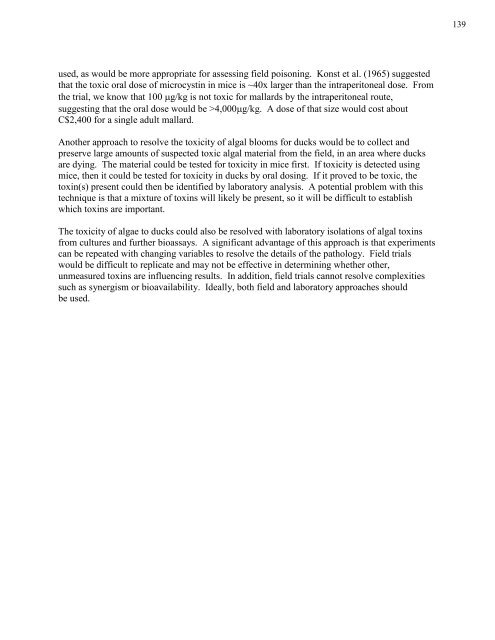Ecology and Management of Avian Botulism on the Canadian Prairies
Ecology and Management of Avian Botulism on the Canadian Prairies
Ecology and Management of Avian Botulism on the Canadian Prairies
You also want an ePaper? Increase the reach of your titles
YUMPU automatically turns print PDFs into web optimized ePapers that Google loves.
139used, as would be more appropriate for assessing field pois<strong>on</strong>ing. K<strong>on</strong>st et al. (1965) suggestedthat <strong>the</strong> toxic oral dose <str<strong>on</strong>g>of</str<strong>on</strong>g> microcystin in mice is ~40x larger than <strong>the</strong> intraperit<strong>on</strong>eal dose. From<strong>the</strong> trial, we know that 100 µg/kg is not toxic for mallards by <strong>the</strong> intraperit<strong>on</strong>eal route,suggesting that <strong>the</strong> oral dose would be >4,000µg/kg. A dose <str<strong>on</strong>g>of</str<strong>on</strong>g> that size would cost aboutC$2,400 for a single adult mallard.Ano<strong>the</strong>r approach to resolve <strong>the</strong> toxicity <str<strong>on</strong>g>of</str<strong>on</strong>g> algal blooms for ducks would be to collect <str<strong>on</strong>g>and</str<strong>on</strong>g>preserve large amounts <str<strong>on</strong>g>of</str<strong>on</strong>g> suspected toxic algal material from <strong>the</strong> field, in an area where ducksare dying. The material could be tested for toxicity in mice first. If toxicity is detected usingmice, <strong>the</strong>n it could be tested for toxicity in ducks by oral dosing. If it proved to be toxic, <strong>the</strong>toxin(s) present could <strong>the</strong>n be identified by laboratory analysis. A potential problem with thistechnique is that a mixture <str<strong>on</strong>g>of</str<strong>on</strong>g> toxins will likely be present, so it will be difficult to establishwhich toxins are important.The toxicity <str<strong>on</strong>g>of</str<strong>on</strong>g> algae to ducks could also be resolved with laboratory isolati<strong>on</strong>s <str<strong>on</strong>g>of</str<strong>on</strong>g> algal toxinsfrom cultures <str<strong>on</strong>g>and</str<strong>on</strong>g> fur<strong>the</strong>r bioassays. A significant advantage <str<strong>on</strong>g>of</str<strong>on</strong>g> this approach is that experimentscan be repeated with changing variables to resolve <strong>the</strong> details <str<strong>on</strong>g>of</str<strong>on</strong>g> <strong>the</strong> pathology. Field trialswould be difficult to replicate <str<strong>on</strong>g>and</str<strong>on</strong>g> may not be effective in determining whe<strong>the</strong>r o<strong>the</strong>r,unmeasured toxins are influencing results. In additi<strong>on</strong>, field trials cannot resolve complexitiessuch as synergism or bioavailability. Ideally, both field <str<strong>on</strong>g>and</str<strong>on</strong>g> laboratory approaches shouldbe used.


